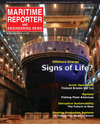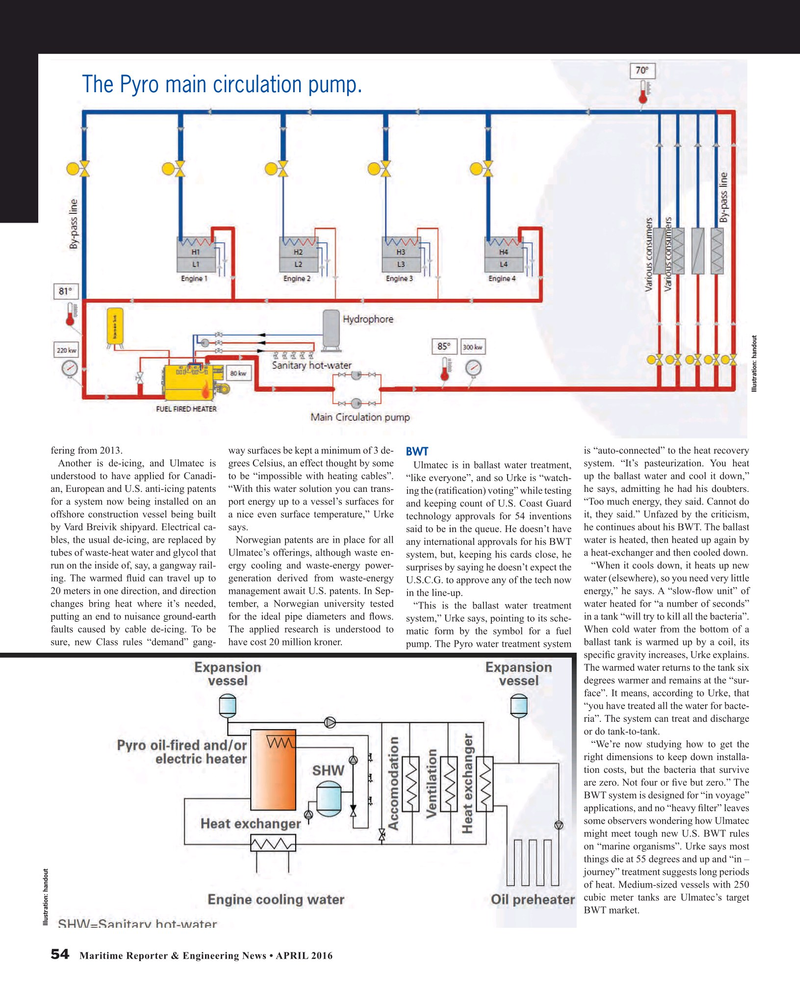
Page 54: of Maritime Reporter Magazine (April 2016)
The Offshore Annual
Read this page in Pdf, Flash or Html5 edition of April 2016 Maritime Reporter Magazine
The Pyro main circulation pump.
Illustration: handout fering from 2013. way surfaces be kept a minimum of 3 de- is “auto-connected” to the heat recovery
BWT
Another is de-icing, and Ulmatec is grees Celsius, an effect thought by some Ulmatec is in ballast water treatment, system. “It’s pasteurization. You heat understood to have applied for Canadi- up the ballast water and cool it down,” to be “impossible with heating cables”. “like everyone”, and so Urke is “watch- an, European and U.S. anti-icing patents “With this water solution you can trans- he says, admitting he had his doubters. ing the (rati? cation) voting” while testing for a system now being installed on an port energy up to a vessel’s surfaces for and keeping count of U.S. Coast Guard “Too much energy, they said. Cannot do offshore construction vessel being built a nice even surface temperature,” Urke technology approvals for 54 inventions it, they said.” Unfazed by the criticism, by Vard Breivik shipyard. Electrical ca- says. said to be in the queue. He doesn’t have he continues about his BWT. The ballast bles, the usual de-icing, are replaced by Norwegian patents are in place for all any international approvals for his BWT water is heated, then heated up again by tubes of waste-heat water and glycol that Ulmatec’s offerings, although waste en- system, but, keeping his cards close, he a heat-exchanger and then cooled down. run on the inside of, say, a gangway rail- ergy cooling and waste-energy power- “When it cools down, it heats up new surprises by saying he doesn’t expect the ing. The warmed ? uid can travel up to generation derived from waste-energy U.S.C.G. to approve any of the tech now water (elsewhere), so you need very little 20 meters in one direction, and direction management await U.S. patents. In Sep- energy,” he says. A “slow-? ow unit” of in the line-up.
changes bring heat where it’s needed, tember, a Norwegian university tested “This is the ballast water treatment water heated for “a number of seconds” putting an end to nuisance ground-earth for the ideal pipe diameters and ? ows. system,” Urke says, pointing to its sche- in a tank “will try to kill all the bacteria”. faults caused by cable de-icing. To be The applied research is understood to matic form by the symbol for a fuel When cold water from the bottom of a sure, new Class rules “demand” gang- have cost 20 million kroner. pump. The Pyro water treatment system ballast tank is warmed up by a coil, its speci? c gravity increases, Urke explains.
The warmed water returns to the tank six degrees warmer and remains at the “sur- face”. It means, according to Urke, that “you have treated all the water for bacte- ria”. The system can treat and discharge or do tank-to-tank. “We’re now studying how to get the right dimensions to keep down installa- tion costs, but the bacteria that survive are zero. Not four or ? ve but zero.” The
BWT system is designed for “in voyage” applications, and no “heavy ? lter” leaves some observers wondering how Ulmatec might meet tough new U.S. BWT rules on “marine organisms”. Urke says most things die at 55 degrees and up and “in – journey” treatment suggests long periods dou Illustration: handout of heat. Medium-sized vessels with 250 cubic meter tanks are Ulmatec’s target
BWT market.
54 Maritime Reporter & Engineering News • APRIL 2016
MR #4 (50-57).indd 54 4/7/2016 1:12:04 PM

 53
53

 55
55
